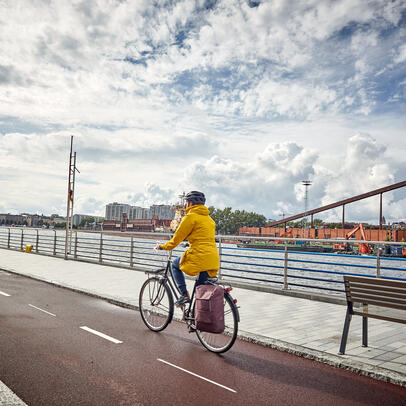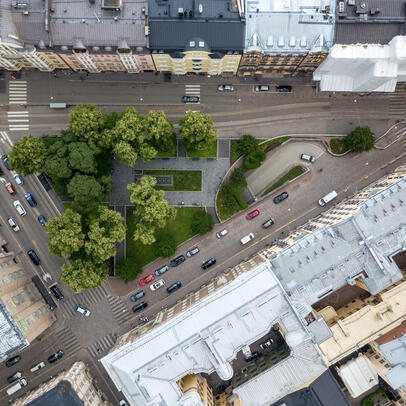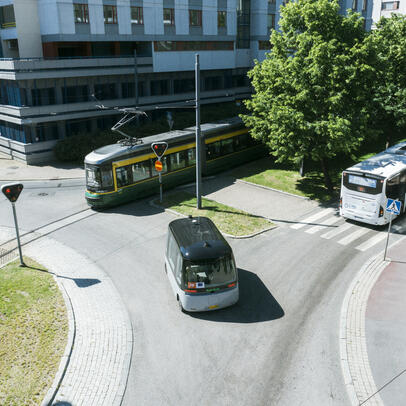Goals of transport and traffic planning
The general principle of Helsinki’s transport and traffic planning is to take care of the needs of pedestrians first. After this, we attend to the needs of bicycle traffic, public transport, commercial transport, and passenger cars – in that order.
We aim to condense the urban structure into diverse city centres and connect them with excellent public transport links. We promote sustainable transport to create a pleasant environment, excellent accessibility, fluent movement and reduce environmental pollution. A thriving economy also needs a functioning transport system.
Helsinki’s Mobility Development Programme defines Helsinki’s transport system’s objectives and policies. The City Board approved the programme in 2015.

Transport development programmes
Traffic safety
Traffic safety is a key starting point for traffic planning. Speed control is an effective way to improve traffic safety, as the risks of accidents increase with speed. The consequences of an accident also largely depend on the collision speed.
Helsinki’s traffic safety has improved significantly in the last few decades, and serious accidents are rare. Helsinki’s traffic safety development programme was updated in 2021. The goal is to continue reducing accidents, particularly those involving children, young adults, pedestrians and cyclists. The city has lowered speed limits and started adding cameras to improve traffic safety.
Helsinki is also improving traffic safety by reorganising traffic and building safer pedestrian routes and cycle lanes. The city centre is planned to mainly have one-way cycling arrangements in the future. There’s plenty to be done in the city-wide, 130-kilometre Baana network, as well.
Learn more about Helsinki's traffic safety development programme 2022–2026 (in Finnish).
Traffic planning methods for improving traffic safety
Speeds limits are reduced in new housing areas by avoiding straight, excessively wide drive-through streets. Old areas often require other solutions, including speed bumps and elevated pedestrian crossings.
Speed bumps are an efficient and cost-effective way to control speeds. Because there is more demand for speed bumps than is possible to provide with the current budget, we are prioritising areas where the routes of schoolchildren and busy vehicle traffic intersect. Speed bumps are not suitable for areas with soft clay soil because of the vibrations from traffic. They are only planned for streets with bus routes under special conditions.
Raised crosswalks work for reducing speeds at important pedestrian crossings, but they are significantly more expensive than a standard speed bump.
Raised junctions improve safety for all forms of traffic but are the most expensive of all the raised speed control solutions.
Roundabouts reduce speeds efficiently. Dozens of roundabouts have been built in Helsinki since the early '90s, and they have successfully reduced accidents.
Narrowed roadways and curves reduce speeds, especially when vehicles pass each other. Street-side parking can also function as a traffic calming device.
A crossing island is a solution that facilitates crossing the street. A long island in the middle of the street can calm traffic at bus stops, as it prevents vehicles from passing the bus.
Street markings and speed displays are effective ‘reminders’ and boost the effects of traffic signs. Speed displays are excellent for areas with soft clay since speed bumps cannot be built there due to the vibrations from traffic.
Traffic lights improve safety at junctions efficiently and allow pedestrians and cyclists to cross streets safely. Traffic light placement is determined by the amount of vehicle traffic, the street speed limit, and the number of pedestrian crossings.
Signal lights at pedestrian crossings warn drivers about pedestrians entering crossings.
Mixed-use streets are for both pedestrians and vehicles, but pedestrians have the right of way. The speed limit on mixed-use streets is 20 kilometres per hour. A mixed-use street is not simply established with a traffic sign, but the street environment must also be appropriate: a mixed-use street can be narrowed, have raised areas, planters, and benches that control speeds. Mixed-use streets are usually already placed in the detailed plan.
Traffic control is the responsibility of the police. In addition to traditional control methods, the police use automatic traffic control equipment. The City of Helsinki has installed traffic surveillance equipment for the police and will build 70 new control points between 2020 and 2024.
Drive-through bans are now seldom used to improve traffic safety. They are inefficient, because the police barely have the means to enforce them. Instead, we aim to direct drive-through traffic away from residential streets by other means, such as speed limits and traffic calming devices. The best way to reduce drive-through traffic is to make another route more appealing.
A road sign warning of children is used in the immediate vicinity of schools, day-care centres and playgrounds, for example, on streets that border the school property or city block. The signs are not usually used on streets that are further away.


